Effect of Ionic Strength on the Performance of Dye-sensitized Solar Cells Based on Natural Dyes
Ateyyah M. AL-Baradi
Taif University, Faculty of Science, Physics department, Taif, Saudi Arabia.
Corresponding Author E-mail : thobyani@yahoo.com
DOI : http://dx.doi.org/10.13005/ojc/360422
Article Received on : 22 May 2020
Article Accepted on :
Article Published : 27 Aug 2020
This work is concerned with the improvement of the use of natural dyes in dye-sensitized solar cells (DSSCs). Red cabbage dye has been extracted and used to fabricate DSSCs with and without the addition of NaCl salt. The absorption of the extracted dye as a function of salt concentration has been investigated by spectrophotometer showing an increase of the absorption intensity with increasing the ionic strength due to the aggregation of the dye molecules. Fourier-transform infrared spectroscopy (FTIR) has been utilised to observe the bonding effect in the extracted dye upon the addition of salt. The FTIR spectra have shown a shift towards a higher wavenumber at the O-H stretching vibration indicating the aggregation caused by the addition of salt ions. The photovoltaic performance of the DSSCs based on red cabbage dye as a function of salt concentration has been studied. The overall power conversion efficiency has been found to increase from 0.03% to 0.20% with increasing the salt concentration up to 5M.
KEYWORDS:Dye-Sensitized Solar Cells; Efficiency Improvement; Ionic Strength Effect; Natural Dyes; Red Cabbage
Download this article as:| Copy the following to cite this article: AL-Baradi A. M. Effect of Ionic Strength on the Performance of Dye-sensitized Solar Cells Based on Natural Dyes. Orient J Chem 2020;36(4). |
| Copy the following to cite this URL: AL-Baradi A. M. Effect of Ionic Strength on the Performance of Dye-sensitized Solar Cells Based on Natural Dyes. Orient J Chem 2020;36(4). Available from: https://bit.ly/3hyCkzx |
Introduction
In the last three decades, there has been an increasing attention paid to dye-sensitized solar cells (DSSCs) since its discovery by Graetzil and co-workers due to their low cost and ease of fabrication.1-3 This generation of solar cells is a promising technology as a replacement of conventional solar cells especially after the reasonable achieved efficiency around 22% when highly effective materials like perovskite are used under particular conditions.4-6 Although these high efficient cells are solid-state DSSCs, recent research is still currently considering the liquid electrolyte-based DSSCs.7-11 A dye-sensitized solar cell consists of a porous wide-bandgap semiconductor (TiO2) sensitized with a dye in the presence of an electrolyte. These components are sandwiched between two electrodes that made of a highly transparent conducting glass. There have been many attempts to improve the performance of each component in DSSCs.12-15 The main component in DSSCs is the sensitizer (dye) that makes these cells mimicking the photosynthesis in nature, which has received a noticeable amount of research.16-19 There are certain requirements that should be fulfilled for an efficient dye, such as the high absorption in the visible region, strong adsorption onto the TiO2 surface, capability of injecting electrons to the conduction band of the semiconductor.20-22 The best performance of DSSCs has been obtained by using Ruthenium-based (Ru) dyes developed by Gratzil and co-workers including N3, N719 and black dyes.16, 23 The use of such sensitizers has led to a sufficient absorption in addition to a minimum back recombination rate. However, Ru metals and their resources are very expensive and toxic materials that cannot be trusted for a wide range of applications. Therefore, natural dyes are potential alternatives with acceptable power conversion efficiency (PCE).24-27 Such photosensitizers have many advantages over synthetic Ru-based dyes including the ease of availability, non-toxicity, the low cost of their fabricated devices and they are environmentally friendly. Over the past decade, a large number of natural dyes have been used as sensitizers to fabricate DSSCs, for example, chlorophyll, carotene.27, 28 These dyes can be extracted from many fruits, roses and plants leaves such as herbs, red-cabbage, curcumin, red-perilla and many others.28-30 The efficiency of the prepared DSSCs from these natural sensitizers varies from 0.03% to 0.7% when used as extracted. However, several structural modifications of some dyes, such as coumarin and its derivatives have led to a considerable improvement of the efficiency to 7.6%.31, 32
In this work, a natural dye extracted from red cabbage has been treated using salt ions in order to improve the efficiency of the fabricated DSSCs. The optical properties of the prepared dye solutions with and without salt will be studied. Fourier transform infrared (FTIR) will be utilized to explore the molecular structure of the extracted natural dye before and after the addition of salt ions. The photovoltaic properties of the prepared DSSCs will be investigated.
Materials and Methods
Certain amounts of NaCl (0.03-1.46 g) were dissolved in distilled water to obtain salt solutions between 0.1 M to 5 M. Red cabbage, with a molecular structure shown in figure 1, was dried in a vacuum oven for five days then grinded to obtain a powder. 0.04 g of the red cabbage powder was dissolved in 4 mL of pure water and the salt solutions mentioned above. The resulting solutions were then filtered using 0.5 μm filter paper. Ready-coated TiO2 films on fluorine-doped tin oxide (FTO) glass (from Solanonix) were dipped in the solutions for 12 h. The obtained photoelectrodes with the loaded dyes were then removed and washed with acetonitrile. These photoelectrodes were used to construct dye-sensitized solar cells by placing a counter electrode (platinum coated transparent conducting oxide (TCO)) on the top of the photoelectrode, which were hold together using paper clips. The space between the front and counter electrodes was filled with a liquid electrolyte (from Solaronix) through a pinhole on the counter electrode. A 0.25 cm2 illuminated area was made on the back side of the photoelectrode by using a mask from a black tape. A photovoltaic system consisting of a solar simulator (Solar-Light) and an electrometer (Keithley 2400) was utilized to obtain the I-V characteristics of the prepared DSSCs. The system is computer-controlled to acquire and plot the I-V data after AM1.5-filtered light from the 300 WXenon lamp of the solar simulator shines the DSSC at a power density Pi=100 mW/cm.2 The absorption of the obtained dyes was investigated using a JASCO double-beam UV-vis spectrophotometer (model V-670). Fourier-transform infrared spectroscopy (FTIR) spectra were recorded by utilizing Alpha-Attenuated FTIR spectrophotometer, Bruker, in the range of 400-4000 cm-1 at room temperature.
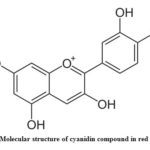 |
Figure 1: Molecular structure of cyanidin compound in red cappage. |
Results and Discussion
The absorption spectra of the extracted red cabbage dye were recorded as a function of the concentration of NaCl using UV-vis spectrophotometer as shown in Figure 2. It is clear from this figure that the used dye has an absorption beak at around 550 nm. NaCl ions have no effect on this absorption beak at all concentrations. However, the absorption intensity increases with increasing the concentration of the salt ions. This can be attributed to the aggregation of the dye molecules cased by the salt ions effects on the OH groups in the cyanidin compound in the red cabbage (see figure 1). A similar effect of NaCl salt ions was observed in previous studies33 on organic dyes using time-resolved surface second harmonic generation (TRSSHG) technique to investigate the interfacial properties of the liquid/dye system.
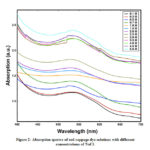 |
Figure 2: Absorption spectra of red-cappage dye solutions with different concentrations of NaCl. |
Figure 3 shows the FTIR spectra of the extracted red cabbage dye at different NaCl concentrations. The transmittance beaks in this figure between 1050 cm-1 and 1250 cm-1 are corresponding to the C-O stretching vibrations, which are not affected by the addition of salt ions. The figure shows also transmittance beaks at 1500 cm-1 and 1700 cm-1 corresponding to C=C and C=O stretching vibrations, respectively, with no changes upon the addition of salt ions. The stretching vibration at 3350 cm-1 is due to the O-H bonding. The shift towards a higher frequency in the O-H bonding means a shorter O-H bonding due to the electronegativity from the neighboring atoms. In addition, the transmittance decreases at this point with increasing the salt concentration, which might be attributed to the aggregation of the dye molecules. This is another evidence of the effect of the links caused by the NaCl ions.
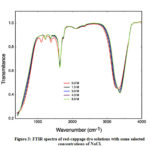 |
Figure 3: FTIR spectra of red-cappage dye solutions with some selected concentrations of NaCl. |
Figure 4 illustrates the I-V characteristics of DSSCs based on the extracted red cabbage dye with and without the addition of NaCl. Although the obtained efficiency from the red cabbage dye sensitized solar cells are quite low, similar to the literature,30 it is clear from figure 4 that the performance of the DSSCs improved with increasing the concentration of the salt ions. The obtained cell parameters are listed in table 1. The fill factor of the curves increased from 0.27 to over 0.75 indicating the worthy performance of the DSSCs upon the addition of salt ions. Table I shows the increase of the efficiency of the DSSCs based on red cabbage dye from 0.03% to 0.20% with increasing the salt concentration from 0M to 5M. This is due to the increase of the absorption of the dye mentioned above that resulted in the increase of the photocurrent in the DSSCs with increasing the salt concentration (see figure 5). The sharp increase in the photocurrent in figure 5 as a function of salt concentration means more charge carriers are transferred to the semiconductor due to the increase of the dye aggregates in the dye/TiO2 interface upon the addition of NaCl. A similar aggregation effect has been observed using other organic dyes in the literature.34 Figure 6 shows the increase of the photovoltage at low concentrations of NaCl until a constant value of about 0.46 V is reached at high NaCl concentrations. This increase of Voc can be attributed to the help of the aggregates caused by the addition of salt ions to decrease the recombination rate in the DSSCs. The increase of the photocurrent and photovoltage upon the addition of salt resulted in a noticeable increase of the power conversion efficiency of the DSSCs based on red cabbage dye as a function of NaCl concentration as shown in figure 7.
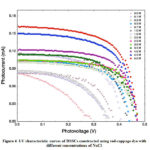 |
Figure 4: I-V characteristic curves of DSSCs constructed using red-cappage dye with different concentrations of NaCl. |
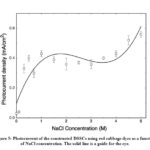 |
Figure 5: Photocurrent of the constructed DSSCs using red cabbage dyes as a function of NaCl concentration. The solid line is a guide for the eye. |
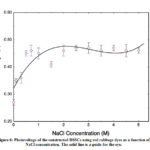 |
Figure 6: Photovoltage of the constructed DSSCs using red cabbage dyes as a function of NaCl concentration. The solid line is a guide for the eye. |
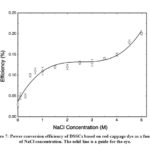 |
Figure 7: Power conversion efficiency of DSSCs based on red-cappage dye as a function of NaCl concentration. The solid line is a guide for the eye. |
Table 1: I-V characteristics parameters of DSSCs prepared with a natural dye with concentrations of salt.
|
Salt conc. (M) |
Voc (V) |
Jsc (mA) |
FF |
η(%) |
Rcell (Ω) |
|
0.0 |
0.27 |
0.03 |
0.27 |
0.03 |
139 |
|
0.1 |
0.35 |
0.04 |
0.41 |
0.05 |
110 |
|
0.3 |
0.36 |
0.33 |
0.44 |
0.05 |
99 |
|
0.5 |
0.45 |
0.40 |
0.57 |
0.10 |
89 |
|
0.7 |
0.46 |
0.30 |
0.78 |
0.11 |
110 |
|
1.0 |
0.45 |
0.43 |
0.57 |
0.11 |
95 |
|
1.5 |
0.41 |
0.39 |
0.75 |
0.12 |
101 |
|
2.0 |
0.46 |
0.36 |
0.72 |
0.12 |
87 |
|
2.5 |
0.47 |
0.37 |
0.76 |
0.13 |
113 |
|
3.0 |
0.47 |
0.36 |
0.78 |
0.13 |
57 |
|
3.5 |
0.46 |
0.40 |
0.73 |
0.14 |
97 |
|
4.0 |
0.47 |
0.43 |
0.74 |
0.15 |
103 |
|
4.5 |
0.46 |
0.52 |
0.73 |
0.18 |
89 |
|
5.0 |
0.46 |
0.56 |
0.75 |
0.20 |
87 |
Conclusions
DSSCs have been successfully constructed based on red cabbage dye with different concentrations of NaCl. The absorption of the red cabbage dye was measured by the spectrophotometer showing an increase with increasing the salt concentration due to the aggregation of the dye molecules. This aggregation behavior was also confirmed by the FTIR measurements that showed a shift towards a higher frequency of the peak corresponding to the O-H stretching vibration. The photovoltaic performance of the DSSCs based on red cabbage dye as a function of NaCl was studied. A better performance was obtained with increasing the salt concentration up to 5M resulting in an increase of the power conversion efficiency from 0.03% to 0.20%.
Acknowledgement
The author thanks Dr. Ali Badawi for his support during this work.
Conflicts of Interest
The author declares no conflict of interest.
References
- O’regan, B.; Grätzel, M., nature 1991, 353, 737-740.
CrossRef - Schmidt-Mende, L.; Zakeeruddin, S. M.; Grätzel, M., Applied Physics Letters 2005, 86, 013504.
CrossRef - Hardin, B. E.; Hoke, E. T.; Armstrong, P. B.; Yum, J.-H.; Comte, P.; Torres, T.; Fréchet, J. M.; Nazeeruddin, M. K.; Grätzel, M.; McGehee, M. D., Nature photonics 2009, 3, 406-411.
CrossRef - Grätzel, M., Nature materials 2014, 13, 838-842.
CrossRef - Liu, Y.; Akin, S.; Pan, L.; Uchida, R.; Arora, N.; Milić, J. V.; Hinderhofer, A.; Schreiber, F.; Uhl, A. R.; Zakeeruddin, S. M., Science advances 2019, 5, eaaw2543.
CrossRef - Park, N.-G.; Miyasaka, T.; Grätzel, M., Cham, Switzerland: Springer
- AL-Baradi, A. M., Results in Physics 2020, 103109.
CrossRef - Badawi, A.; Al-Gurashi, W. O.; Al-Baradi, A. M.; Al-Hosiny, N., Materials Science in Semiconductor Processing 2019, 95, 1-6.
CrossRef - Maddah, H. A.; Berry, V.; Behura, S. K., Renewable and Sustainable Energy Reviews 2020, 121, 109678.
CrossRef - Michaels, H.; Rinderle, M.; Freitag, R.; Benesperi, I.; Edvinsson, T.; Socher, R.; Gagliardi, A.; Freitag, M., Chemical Science 2020, 11, 2895-2906.
CrossRef - Gao, N.; Huang, L.; Li, T.; Song, J.; Hu, H.; Liu, Y.; Ramakrishna, S., Journal of Applied Polymer Science 2020, 137, 48443.
CrossRef - Gong, J.; Sumathy, K.; Qiao, Q.; Zhou, Z., Renewable and Sustainable Energy Reviews 2017, 68, 234-246.
CrossRef - Kavan, L.; Vlckova Zivcova, Z.; Zlamalova, M.; Zakeeruddin, S. M.; Grätzel, M., The Journal of Physical Chemistry C 2020, 124, 6512-6521.
CrossRef - Mehmood, U.; Asghar, H.; Babar, F.; Younas, M., Solar Energy 2020, 196, 132-136.
CrossRef - Xu, T.; Kong, D.; Tang, H.; Qin, X.; Li, X.; Gurung, A.; Kou, K.; Chen, L.; Qiao, Q.; Huang, W., ACS omega 2020, 5, 8687-8696.
CrossRef - Semalti, P.; Sharma, S. N., Journal of nanoscience and nanotechnology 2020, 20, 3647-3658.
CrossRef - Vinosha, P. A.; Ragu, R.; Kalaiarasi, S.; Xavier, B.; Das, S. J., Chemical Physics Letters 2020, 137644.
- Krishna, J. G.; Ojha, P. K.; Kar, S.; Roy, K.; Leszczynski, J., Nano Energy 2020, 70, 104537.
CrossRef - Carvalho, I.; Barbosa, M.; Costa, M.; Longo, E.; Cavalcante, L.; Viana, V.; Santos, R., Optik 2020, 165236.
CrossRef - Xiao, B.-C.; Lin, L.-Y., Nanomaterials 2020, 10, 13.
CrossRef - Omar, A.; Ali, M. S.; Abd Rahim, N., Solar Energy 2020, 207, 1088-1121.
CrossRef - Yang, X.; Zhao, L.; Lv, K.; Dong, B.; Wang, S., Applied Surface Science 2019, 469, 821-828.
CrossRef - Nam, S.-H.; Lee, K. H.; Yu, J.-H.; Boo, J.-H., Applied Science and Convergence Technology 2019, 28, 194-206.
CrossRef - Chang, H.; Kao, M.-J.; Chen, T.-L.; Kuo, C.-G.; Cho, K.-C.; Lin, X.-P., American Journal of Engineering and Applied Sciences 2011, 4.
- Calogero, G.; Di Marco, G., Solar Energy Materials and Solar Cells 2008, 92, 1341-1346.
CrossRef - Gokilamani, N.; Muthukumarasamy, N.; Thambidurai, M.; Ranjitha, A.; Velauthapillai, D., Journal of sol-gel science and technology 2013, 66, 212-219.
CrossRef - Narayan, M. R., Renewable and Sustainable Energy Reviews 2012, 16, 208-215.
- Zhou, H.; Wu, L.; Gao, Y.; Ma, T., Journal of Photochemistry and Photobiology A: Chemistry 2011, 219, 188-194.
CrossRef - Gómez-Ortíz, N.; Vázquez-Maldonado, I.; Pérez-Espadas, A.; Mena-Rejón, G.; Azamar-Barrios, J.; Oskam, G., Solar Energy Materials and Solar Cells 2010, 94, 40-44.
CrossRef - Furukawa, S.; Iino, H.; Iwamoto, T.; Kukita, K.; Yamauchi, S., Thin solid films 2009, 518, 526-529.
CrossRef - Bella, F.; Sacco, A.; Pugliese, D.; Laurenti, M.; Bianco, S., Journal of Power Sources 2014, 264, 333-343.
CrossRef - Ganta, D.; Jara, J.; Villanueva, R., Chemical physics letters 2017, 679, 97-101.
CrossRef - Fedoseeva, M.; Fita, P.; Punzi, A.; Vauthey, E., The Journal of Physical Chemistry C 2010, 114, 13774-13781.
CrossRef - Gao, J.; El-Zohry, A. M.; Trilaksana, H.; Gabrielsson, E.; Leandri, V.; Ellis, H.; D’Amario, L.; Safdari, M.; Gardner, J. M.; Andersson, G., ACS applied materials & interfaces 2018, 10, 26241-26247.
CrossRef

This work is licensed under a Creative Commons Attribution 4.0 International License.









